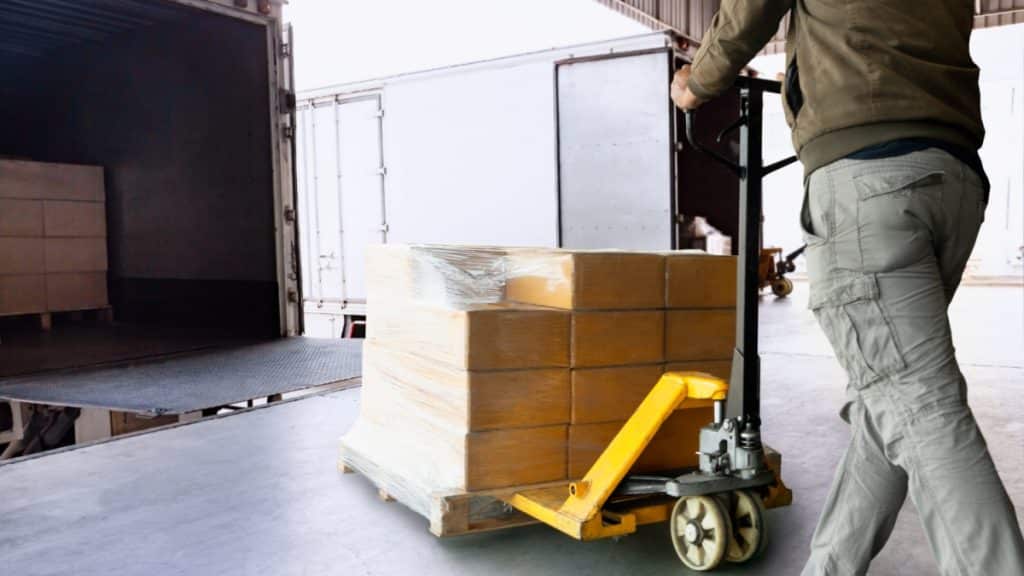Which type of pallet to choose—wooden, plastic, or perhaps metal? And does it even matter? The truth is that making the wrong choice can significantly increase costs and complicate handling. Shipping pallets affect the efficiency of transportation, storage, and overall costs. In this article, we will take a detailed look at different types of pallets in logistics, materials, standard pallet dimensions, and their uses. Read our article to find out how to choose the right one for your needs!
What Are Shipping Pallets?
Shipping pallets are sturdy platforms that facilitate the easy handling of goods during transportation and storage. These pallets support the efficient use of space and minimize the risk of product damage.
Comparison of Pallets by Material
For better clarity, we have prepared a comparative table of the main types of pallets, which we will describe in detail later.
| Material | Advantages | Disadvantages | Typical Use |
| Wood | Low cost, high load-bearing capacity | Susceptible to moisture, shorter lifespan | General logistics, construction industry |
| Plastic | Hygienic, resistant to chemicals | Higher cost | Food industry, pharmaceutical industry |
| Metal | High strength, durability | High weight, cost | Heavy industry, automotive industry |
| Paper | Eco-friendly, recyclable | Low load capacity, limited durability | Single-use transport, export packaging |
1) Wooden Pallets
Wooden pallets are the traditional and most commonly used type in logistics. Made from solid wood or plywood, they meet a wide range of requirements due to their strength and versatility.
Characteristics:
- Load capacity: Up to 1,500 kg (3,300 lb).
- Advantages: Low cost, easy to repair, widely available.
- Disadvantages: Susceptible to moisture and pest infestation.
Usage:
Wooden pallets are suitable for various industries, from construction to retail. They are also popular in international transport due to their easy availability and custom production options. Additionally, wooden pallets make up about 90% of the global pallet consumption due to their low cost.
2) Plastic Pallets
Plastic pallets are a more modern alternative, especially suitable for environments where hygiene is a priority. These pallets are made from polyethylene or polypropylene.
Characteristics:
- Load capacity: Up to 1,000 kg (2,200 lb).
- Advantages: Resistant to moisture, easy to clean, long lifespan.
- Disadvantages: Higher initial cost.
Usage:
Due to their hygienic properties, plastic pallets are ideal for the food and pharmaceutical industries. They are also suitable for international transport, where fumigation is not required. Plastic pallets account for 5-7% of the global pallet market, but demand is increasing due to growing hygiene requirements.
3) Metal Pallets
Metal pallets are ideal for special purposes in heavy industry or the automotive sector.
Characteristics:
- Load Capacity: Up to 2,000 kg (4,400 lb).
- Advantages: High strength, chemical resistance, long lifespan.
- Disadvantages: High weight, higher costs.
Usage:
These pallets are commonly used for transporting heavy machinery, parts, and chemicals.
4) Paper Pallets
Lightweight and eco-friendly paper pallets are ideal for transporting lighter products and are designed for single use.
Characteristics:
- Load Capacity: Up to 500 kg (1,100 lb).
- Advantages: Low weight, recyclable.
- Disadvantages: Low moisture resistance.
Usage:
Paper pallets are commonly used for one-time export orders and the transport of lightweight products. The demand for eco-friendly paper pallets has increased by 12% due to a growing focus on sustainability.
Standard pallet dimensions in logistics
| Pallet Type | Dimensions (mm/in) | Usage |
| Europallet | 1200 × 800 (47 × 32) | Standard for European logistics |
| Industrial Pallet | 1200 × 1000 (47 × 39) | Versatile use in storage |
| Asian Pallet | 1100 × 1100 (43 × 43) | Suitable for regional transport in Asia |
| American Pallet | 1219 × 1016 (48 × 40) | Suitable for the North American market |
The standard pallet dimensions allow for efficient handling and storage in containers and warehouses. Euro pallets are the most common in Europe, while American pallets dominate the North American market.
Shipping Pallets—More Than Just Support for Your Goods
Whether you choose wooden pallets that can handle heavy loads or hygienic plastic pallets suitable for specific industries, the key to successful logistics lies in the right selection. Standard pallet dimensions and their proper use can make the difference between smooth operations and unnecessary complications.
Don’t underestimate the importance of this humble yet crucial element of the supply chain. The right pallet will save you time, money, and energy—and that’s exactly the goal of modern logistics.
Sources used:
https://www.easycargo3d.com/en/blog/how-are-mixed-pallet-boxes-stacked
